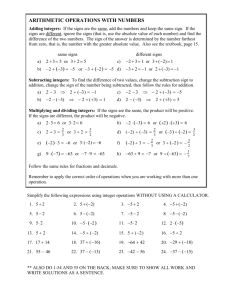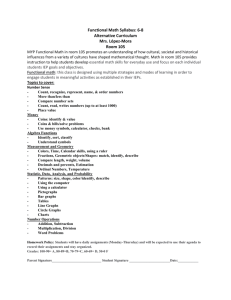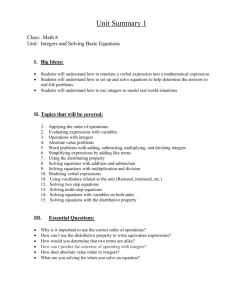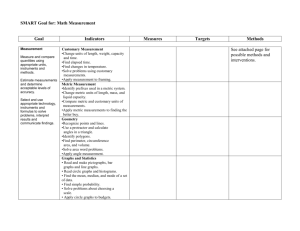7th Grade Mathematics Scope and Sequence
advertisement
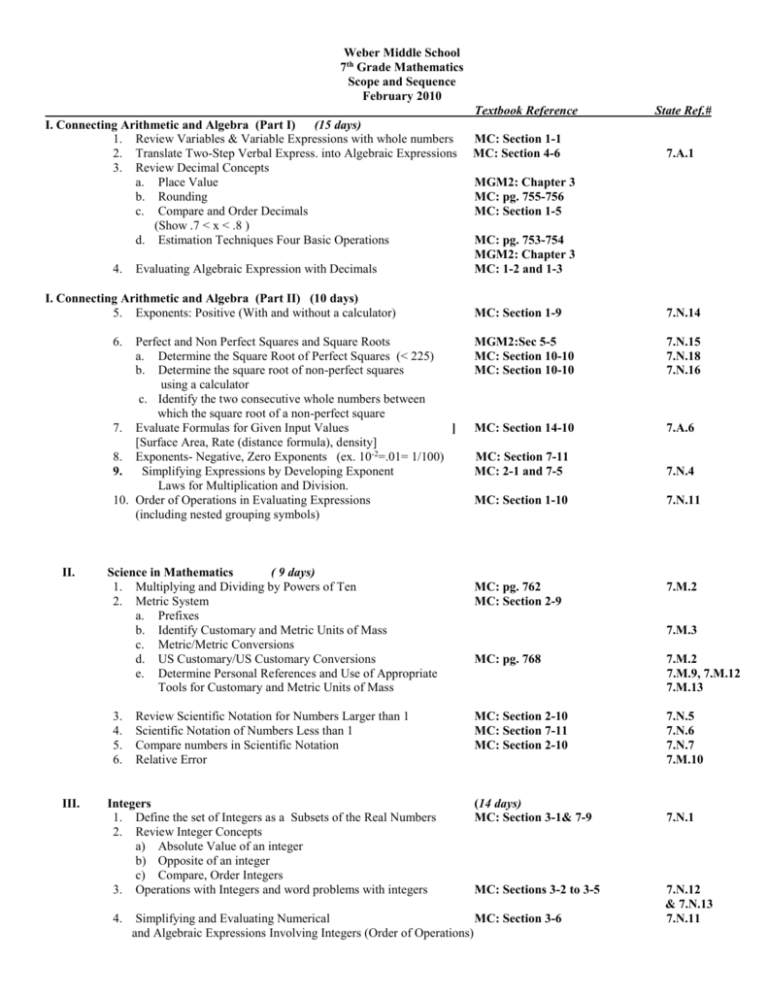
Weber Middle School 7th Grade Mathematics Scope and Sequence February 2010 Textbook Reference I. Connecting Arithmetic and Algebra (Part I) (15 days) 1. Review Variables & Variable Expressions with whole numbers 2. Translate Two-Step Verbal Express. into Algebraic Expressions 3. Review Decimal Concepts a. Place Value b. Rounding c. Compare and Order Decimals (Show .7 < x < .8 ) d. Estimation Techniques Four Basic Operations 4. Evaluating Algebraic Expression with Decimals I. Connecting Arithmetic and Algebra (Part II) (10 days) 5. Exponents: Positive (With and without a calculator) 6. Perfect and Non Perfect Squares and Square Roots a. Determine the Square Root of Perfect Squares (< 225) b. Determine the square root of non-perfect squares using a calculator c. Identify the two consecutive whole numbers between which the square root of a non-perfect square 7. Evaluate Formulas for Given Input Values ] [Surface Area, Rate (distance formula), density] 8. Exponents- Negative, Zero Exponents (ex. 10-2=.01= 1/100) 9. Simplifying Expressions by Developing Exponent Laws for Multiplication and Division. 10. Order of Operations in Evaluating Expressions (including nested grouping symbols) II. Science in Mathematics ( 9 days) 1. Multiplying and Dividing by Powers of Ten 2. Metric System a. Prefixes b. Identify Customary and Metric Units of Mass c. Metric/Metric Conversions d. US Customary/US Customary Conversions e. Determine Personal References and Use of Appropriate Tools for Customary and Metric Units of Mass 3. 4. 5. 6. III. Review Scientific Notation for Numbers Larger than 1 Scientific Notation of Numbers Less than 1 Compare numbers in Scientific Notation Relative Error Integers 1. Define the set of Integers as a Subsets of the Real Numbers 2. Review Integer Concepts a) Absolute Value of an integer b) Opposite of an integer c) Compare, Order Integers 3. Operations with Integers and word problems with integers 4. MC: Section 1-1 MC: Section 4-6 State Ref.# 7.A.1 MGM2: Chapter 3 MC: pg. 755-756 MC: Section 1-5 MC: pg. 753-754 MGM2: Chapter 3 MC: 1-2 and 1-3 MC: Section 1-9 7.N.14 MGM2:Sec 5-5 MC: Section 10-10 MC: Section 10-10 7.N.15 7.N.18 7.N.16 MC: Section 14-10 7.A.6 MC: Section 7-11 MC: 2-1 and 7-5 7.N.4 MC: Section 1-10 7.N.11 MC: pg. 762 MC: Section 2-9 7.M.2 7.M.3 MC: pg. 768 7.M.2 7.M.9, 7.M.12 7.M.13 MC: Section 2-10 MC: Section 7-11 MC: Section 2-10 7.N.5 7.N.6 7.N.7 7.M.10 (14 days) MC: Section 3-1& 7-9 MC: Sections 3-2 to 3-5 Simplifying and Evaluating Numerical MC: Section 3-6 and Algebraic Expressions Involving Integers (Order of Operations) 7.N.1 7.N.12 & 7.N.13 7.N.11 (approximately end of Quarter 1) IV. V. Equations (14 days) 1. Review Solving an equation with Addition or Subtraction 2. Review Solving an equation with Multiplication or Division 3. Review Solving an equation with More Than One Operation 4. Solving One-Step inequalities and graphing the solution on a number line (positive coefficients only) 5. Review Translating verbal sentences into equations and solving. 6. Review Ratio and Proportion 7. Review Solving Proportions Algebraically 8. Review Solving proportions in context Statistics & Probability (16 days) 1. Read and Interpret Graphs a) Pictograph b) Single and Double Bar Graphs c) Histogram d) Single and Double Line Graphs e) Circles Graphs 2. Identify and collect data using a variety of methods 3. Misleading Graphs 4. Organization and display of data a) Double Line Graphs b) Review drawing and measuring angles with a protractor c) Determining the central angle of a sector in a circle graph.. d) Circles Graphs 5. Statistical Measures a) Range b) Mean c) Median d) Mode e) Sampling-determine validity of sampling method f) Select appropriate measure of central tendency (Approximately end of quarter 2) 6. 7. (9 days) Venn diagrams Empirical Probability a) Interpret data to make predictions b) Predict outcomes of Experiments c) Design and Conduct Experiments MC: Section 4-3 MC: Section 4-4 MC: Section 4-5 6.A.4 7.A.5 & 7.G.10 MC: Section 9 - 2 MC: Section 9 – 4 6.A.5 MC: Section 5-1 7.S.6 MC: Section 5-1 MC: Section 11-3 MC: Section 5-3 MC: Section 11-6 Integrated Math Course I MC: Section 5-7 7.S.1 7.S.7 MC: Section 5-4 MC: Section 6- 2 7.S.3 MC: Section 11-7 MC: Section 5-8 7.S.2 & 7.M.8 7.S.4 MC: Section 5-9 7.S.9 7.S.5 MC: Section 12 – 5 6.S.3 MC: Section 12-8 MC: Section 12-7 & 12-8 MC: Section 12-7 7.S.8 7.S.10 7.S.11 MC: pg. 763 Skills MC: Section 7-1 7.N.10 MC: Section 7-2 7.N.8 MC: Section 7 -3 7.N.9 (Use Clever Counting –Connected Mathematics-Probability) VI. Number Theory (15 days) 1. Divisibility Rules 2. Prime and Composite Numbers 3. Prime Factorization (written in exponential form) 4. Find the Greatest Common Factor with whole Numbers using prime factorization 5. Find the Least Common Multiple with whole numbers using prime factorization. V11. Geometry 1. 2. 3. 4. 5. 9. (8 days) Circles and Circumference( including calculating the radius and diameter given the circumference) Area of Circles (including calculating the radius and diameter given the circumference or area) Identify the bases and faces of 3-dimenional shapes. Surface Area of a Rectangular Prism and a Cylinder using a calculator and estimation techniques (other methods) Volume of Prisms and Cylinders using a given formula and a calculator Sum of angles of quadrilaterals VIII. Equations- Patterns and Functions (15 days) 1. Patterns - using charts, tables, graphs, equations, and expressions. 2. Draw graphic representation from equation or a table of data. MC: Section 10-2 7.G.1 MC: Section 10-4 MC: Section 14-1 MC: Sections 14-2, 14-3 MC: Sections 14-4 & 14-5 7.G.3 7.G.4 & 7.M.11 7.G.2 MC: Section 6-7 7. G.7 7.A.8 7.A.7 MC: Section 3-9 (approximately end of quarter 3) 3. Equations a. Define a polynomial b. Add/Subtract monomials with exponents of one c. Solve Equations Combining Like Terms d. Review the Distributive Property e. Solve Equations Using the Distributive Property f. Solve Equations with Variable on Both Sides IX. Pythagorean Theorem (5 days) 1. Identify parts of a right triangle 2. Develop the Pythagorean Theorem 3. Use the Pythagorean Theorem to find the missing side 4. Determine whether a triangle is a right triangle using a Calculator Post May X. Patterns & Functions 1. Use patterns to find the sum of the measure of the Interior angles of a polygon. 2. Create function tables 3. Write Equation to represent function XI. Units of Measure (7 days) 1. Review Ratio and Proportions 2. Scale Drawing 3. Find Unit Price using proportions 4. Compare Unit Price 5. Convert money between different currencies with the use of an exchange table and calculator. Rational Numbers (Fractions) (if time optional) 1. Equivalent Fractions 2. Comparing Fractions 4. Review Four Basic Operations with MC: Section 15-1 MC: Section 2-2 MC: Section 4-9 MC: Extension page 183 7.A.3 7.A.2 7.A.4 7.A.4 7.A.4 MC: Section 10-11 MC: Section 10-11 MC: Section 10-11 7.G.5 7.G.6 7.G.8 MC: Section 10-11 7.G.9 MC: Section 6-5 MC: Section 2- 6 MC: Section 9-1 and 9-2 MC: Section 9-3 MC: Section 9-1 & 9-2 (10 days) MC: Section 7-4 MC: Section 7-6 & 7.A.5 MC: pg. 764-767 7.A.9 7.G.7 7.A.10 7.M.1 7.M.5 7.M.6 7.M.7 Positive Rational Numbers Textbooks Used: MC = Mathematical Connections: McDougal Littell/ Houghton Mifflin MGM2= Middle Grade Mathematics Course 2: Prentice Hall




